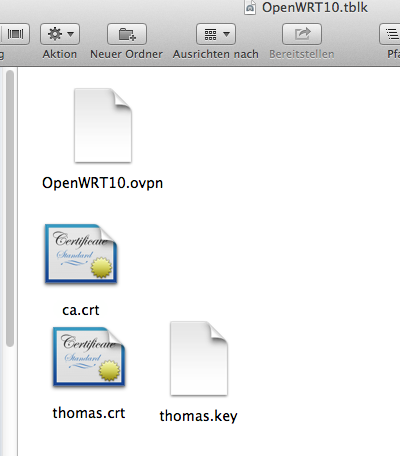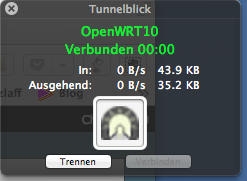Nach dieser guten Anleitung wie folgt vorgehen.
opkg update
opkg install openvpn openvpn-easy-rsa openssh-sftp-server
Zertifikate erstellen:
Optional die
vi /etc/easy-rsa/vars
für default vorbelegungen anpassen:
export KEY_COUNTRY="DE"
export KEY_PROVINCE="Niedersachsen"
export KEY_CITY="Langenhagen"
export KEY_ORG="TWSoft"
export KEY_EMAIL="mail@email.de"
export KEY_EMAIL=mail@email.de
# Der KEY_CN mus EINDEUTIG und EINMALIG sien
export KEY_CN=server.email.de
export KEY_NAME=server.email.de
export KEY_OU=TWSoft
export PKCS11_MODULE_PATH=changeme
export PKCS11_PIN=1234
In das /etc/easy-rsa Verzeichnis wechseln.
./clean-all
ausführen. Löscht das ganze /etc/easy-rsa/keys Verzeichnis
build-ca
Erzeugt diese Fragen:
Country Name (2 letter code) [DE]:
State or Province Name (full name) [DE]:Langenhagen
Locality Name (eg, city) [Langenhagen]:
Organization Name (eg, company) [TWSoft]:
Organizational Unit Name (eg, section) [TWSoft]:
Common Name (eg, your name or your server’s hostname) [EINDEUTIG.wenzlaff.de] www.wenzlaff.de
Name [server.wenzlaff.de]:www.wenzlaff.de
Email Address [mail@email.de]:
Erstellt in /etc/easy-rsa/keys die Dateien:
ca.key
ca.crt
Dann
build-dh
und ein paar Minuten warten bis in /etc/easy-rsa/keys die
dh1024.pem
erzeugt wurde.
Jetzt noch die Server Key erzeugen mit:
build-key-server server
Und einige Fragen beantworten:
Country Name (2 letter code) [DE]:
State or Province Name (full name) [DE]:Hannover
Locality Name (eg, city) [Langenhagen]:
Organization Name (eg, company) [TWSoft]:
Organizational Unit Name (eg, section) [TWSoft]:
Common Name (eg, your name or your server’s hostname) [server]:
Name [server.wenzlaff.de]:
Email Address [mail@email.de]:
Please enter the following ‚extra‘ attributes
to be sent with your certificate request
A challenge password []:1234
An optional company name []:TWSoft
Using configuration from /etc/easy-rsa/openssl-1.0.0.cnf
Check that the request matches the signature
Signature ok
The Subject’s Distinguished Name is as follows
countryName :PRINTABLE:’DE‘
stateOrProvinceName :PRINTABLE:’Hannover‘
localityName :PRINTABLE:’Langenhagen‘
organizationName :PRINTABLE:’TWSoft‘
organizationalUnitName:PRINTABLE:’TWSoft‘
commonName :PRINTABLE:’server‘
name :PRINTABLE:’server.wenzlaff.de‘
emailAddress :IA5STRING:’mail@email.de‘
Certificate is to be certified until Oct 2 18:00:57 2023 GMT (3650 days)
Sign the certificate? [y/n]:y
1 out of 1 certificate requests certified, commit? [y/n]y
Write out database with 1 new entries
Data Base Updated
Nun gibt es in /etc/easy-rsa/keys auch die
server.crt
server.csr
server.key
Alle erzeugten Key in eine .p12 Datei packen mit:
build-key-pkcs12 thomas
Und wieder die gewohnten Fragen beantworten:
Country Name (2 letter code) [DE]:
State or Province Name (full name) [DE]:Hannover
Locality Name (eg, city) [Langenhagen]:
Organization Name (eg, company) [TWSoft]:
Organizational Unit Name (eg, section) [TWSoft]:
Common Name (eg, your name or your server’s hostname) [thomas]:
Name [server.wenzlaff.de]:
Email Address [email@mail.de]:
Please enter the following ‚extra‘ attributes
to be sent with your certificate request
A challenge password []:4567
An optional company name []:TWSoft
Using configuration from /etc/easy-rsa/openssl-1.0.0.cnf
Check that the request matches the signature
Signature ok
The Subject’s Distinguished Name is as follows
countryName :PRINTABLE:’DE‘
stateOrProvinceName :PRINTABLE:’Hannover‘
localityName :PRINTABLE:’Langenhagen‘
organizationName :PRINTABLE:’TWSoft‘
organizationalUnitName:PRINTABLE:’TWSoft‘
commonName :PRINTABLE:’thomas‘
name :PRINTABLE:’server.wenzlaff.de‘
emailAddress :IA5STRING:’mail@email.de‘
Certificate is to be certified until Oct 2 17:59:08 2023 GMT (3650 days)
Sign the certificate? [y/n]:y
1 out of 1 certificate requests certified, commit? [y/n]y
Write out database with 1 new entries
Data Base Updated
Enter Export Password: 0000
Verifying – Enter Export Password: 0000
So jetzt sind auch in /etc/easy-rsa/keys die
thomas.csr
thomas.crt
thomas.key
thomas.p12
Dateien für den Client erstellt worden.
Jetzt müssen die Keys noch auf den Server und den Client verteilt werden.
cd /etc/easy-rsa/keys
cp ca.crt ca.key dh1024.pem server.crt server.key /etc/openvpn/
Hier noch eine kleine Zuordungstabelle, welche Zertifikate wo hinkommen:
Dateiname Speicherort Beschreibung geheim
ca.crt Server + Clients Root CA Zertifikat Nein
ca.key im Safe :) Root CA Schlüssel Ja
dh{Wert}.pem Server Diffie Hellman Nein
server.crt Server Server Zertifikat Nein
server.key Server Server Schlüssel Ja
vpnclient01.crt Client 1 Client 1 Zertifikat Nein
vpnclient01.key Client 1 Client 1 Schlüssel Ja
Server Konfigurieren vi /etc/config/openvpn
config 'openvpn' 'lan'
option 'enable' '1'
option 'port' '1194'
option 'proto' 'udp'
option 'dev' 'tap0'
option 'ca' '/etc/openvpn/ca.crt'
option 'cert' '/etc/openvpn/server.crt'
option 'key' '/etc/openvpn/server.key'
option 'dh' '/etc/openvpn/dh1024.pem'
option 'ifconfig_pool_persist' '/tmp/ipp.txt'
option 'keepalive' '10 120'
option 'comp_lzo' '1'
option 'persist_key' '1'
option 'persist_tun' '1'
option 'status' '/tmp/openvpn-status.log'
option 'verb' '3'
option 'server_bridge' '192.168.2.123 255.255.255.0 192.168.2.122 192.168.2.111'
option 'push' 'redirect-gateway def1'
list 'push' 'dhcp-option DNS 192.168.2.123'
Server Starten mit:
/etc/init.d/openvpn start
und:
/etc/init.d/openvpn stop
Restart
/etc/init.d/openvpn restart
Und für Autostart einmal oder über Luci:
/etc/init.d/openvpn enable
Nur wenn der VPN-Server läuft, ist über Luci das tap0 Device erreichbar.
Im Firewall vi /etc/config/firewall den Port 1194 freischalten:
config 'rule'
option 'target' 'ACCEPT'
option 'dest_port' '1194'
option 'src' 'wan'
option 'proto' 'tcpudp'
option 'family' 'ipv4'
/etc/init.d/firewall restart
Adressbereich setzen vi /etc/config/dhcp
config dhcp lan
option interface lan
option ignore 0
option start 150 # von .150 bis .199 = 49 Adressen
option limit 49
option leasetime 12h
reboot
IPhone Client Konfiguration.
Dafür brauchen wir eine OpenWrt.ovpn Datei. Die müssen wir uns aus den Zertifikaten und Key zusammenbauen:
# TW OpenWrt Configuration für xxx.no-ip.org IP:
remote xx.xxx.xxx.xxx 1194
client
tls-client
dev tun # tap geht nicht mit OpenVpn App 1.01 build 88
proto udp
remote-cert-tls server
resolv-retry infinite
nobind
persist-tun
persist-key
pkcs12 thomas.p12
comp-lzo
verb 3
# hier die Zertifikate von ca.crt, thomas.crt, thomas.key einfügen:
—–BEGIN CERTIFICATE—–
MIIEBDCCA22gAwIBAgIJAgg/WZdmAp
…
+6VIFdXmjy19eZQJzEJFxO5+iqZ6EZhs
—–END CERTIFICATE—–
—–BEGIN CERTIFICATE—–
MIIEQDCCA6mgAwIBAgIBAjANB
…
jGlI9+MUzx3nHhhU1W1F3s4zeeS3TFmjb7xhori4J7JZugOS
—–END CERTIFICATE—–
—–BEGIN PRIVATE KEY—–
gYBxm4LOI4uFPgBmS/9zjEZ1TGyE
…
JUe0BUfOhe4x
—–END PRIVATE KEY—–
An dieser Stelle habe ich gemerkt, das der OpenVPN 1.01 build 88 Client für das iPhone, kein TAP unterstützt.
Die von mir oben gewünschte Bridge über TAP-Device (virtuelle Netzwerkkarte, ethernet Adapter) ist also nicht möglich.
Also umkonfigurieren so das zumindestenst ein OpenVPN TUN läuft.
Also ist kein Layer 2 Tunnel mit dieser App und dem iPhone möglich. Schade!
vi /etc/config/openvpn
config 'openvpn' 'lan'
option 'enable' '1'
option 'port' '1194'
option 'proto' 'udp'
option 'dev' 'tun'
option 'ca' '/etc/openvpn/ca.crt'
option 'cert' '/etc/openvpn/server.crt'
option 'key' '/etc/openvpn/server.key'
option 'dh' '/etc/openvpn/dh1024.pem'
option 'ifconfig_pool_persist' '/tmp/ipp.txt'
option 'keepalive' '10 120'
option 'comp_lzo' '1'
option 'persist_key' '1'
option 'persist_tun' '1'
option 'status' '/var/log/openvpn-status.log'
option 'verb' '3'
option 'server' '10.0.0.0 255.255.255.0'
list 'push' 'redirect-gateway def1'
list 'push' 'dhcp-option DOMAIN lan'
list 'push' 'dhcp-option DNS 192.168.2.1'
vi /etc/config/firewall
config 'include'
option 'path' '/etc/firewall.user' config 'rule'
option 'target' 'ACCEPT' option 'name' 'VPN'
option 'src' 'wan'
option 'proto' 'udp'
option 'dest_port' '1194'
vi /etc/firewall.user
iptables -t nat -A prerouting_wan -p udp --dport 1194 -j ACCEPT
iptables -A input_wan -p udp --dport 1194 -j ACCEPT
iptables -I INPUT -i tun+ -j ACCEPT
iptables -I FORWARD -i tun+ -j ACCEPT
iptables -I OUTPUT -o tun+ -j ACCEPT
iptables -I FORWARD -o tun+ -j ACCEPT
Connect im iPhone läuft schon mal.


